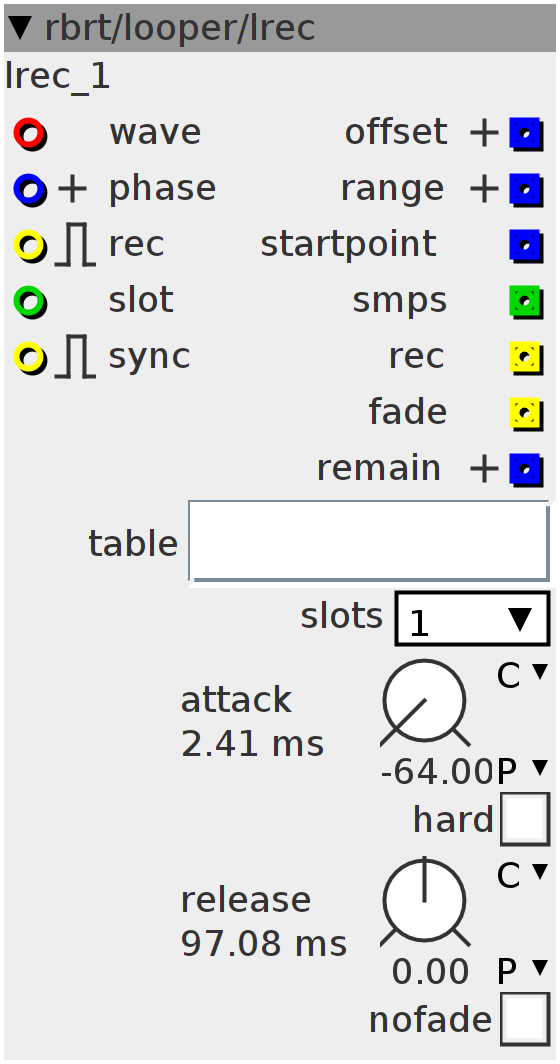lrec
records audio to a table with nice fade-ins and -outs. the table can be divided into 1,2,4 or 8 slots. when 'sync' is enabled,recording will be synced to phase of the signal connected to 'pos', and after 'rec' is zero,recording will continue until the starting point is reached. after recording is done,the length if the recording in samples is sent out, as well as the length of the recording (in fraction of the table's size). meanwhile,the input signal is overdubbed and faded out ,so NO CLICKS! set the length of the fade-out/overdub period with 'release', the length of the fade-in of the recording with 'attack'.
Inlets
int32 select slot to record into
frac32buffer audio in
frac32.positive position inlet for sync-mode
bool32.risingfalling record,set tempo
bool32.risingfalling sync
Outlets
frac32 startpoint when recording in sync
int32 length of recording in samples
bool32 recording state,pre - fadeout
bool32 recording state,post - fadeout
frac32.positive offset inside the table
frac32.positive length of recording in fraction of the table
frac32.positive remaining recording-time for the selected slot
Parameters
frac32.s.map.kdecaytime.exp fade-in time
frac32.s.map.kdecaytime.exp fade-out time
bool32.tgl if 'hard' is on,there will be NO fade-in
bool32.tgl disable fades
Attributes
objref table to record to
combo number of slots in the table
bool rec;
uint32_t recpos;
uint32_t offset;
uint32_t rec_offset;
uint32_t rec_max;
uint8_t shift;
uint32_t start;
uint32_t starthold;
bool mode;
bool recstate;
uint32_t shold;
uint32_t rhold;
int32_t env;
int32_t _ap;
int32_t phase;rec_max = attr_table.LENGTH >> attr_slots;
shift = (27 - attr_table.LENGTHPOW);if ((inlet_rec) && !rec) {
recpos = 0;
rec = 1;
recstate = 1;
start = inlet_phase;
shold = 1 << 27;
rhold = 1 << 27;
starthold = 0;
mode = inlet_sync;
offset = (((inlet_slot) << 21) >> attr_slots) << 6;
rec_offset = (__USAT(offset, 27) >> (27 - attr_table.LENGTHPOW));
}
// fades
if (!param_nofade) {
if (rec)
env = (param_hard)
? (1 << 27)
: (1 << 27) - (___SMMUL((1 << 27) - env, param_attack) << 1);
else
env = ___SMMUL(env, param_release) << 1;
recstate = env;
} else {
recstate = rec;
env = rec << 27;
}
// rec stopped-> wait for rollover if sync is on
if ((!inlet_rec) && rec) {
if (mode) {
phase = (inlet_phase - start) & ((1 << 27) - 1);
if ((phase - _ap) <= 0) {
rec = 0;
shold = recpos - 16;
rhold = shold << shift;
recpos = 0;
starthold = start;
}
_ap = phase;
} else {
rec = 0;
shold = recpos;
rhold = shold << shift;
recpos = 0;
starthold = 0;
}
}
outlet_rec = rec;
outlet_fade = recstate;
outlet_offset = offset;
outlet_range = rhold;
outlet_smps = shold;
outlet_startpoint = starthold;
if (rec)
outlet_remain = ((rec_max - recpos) << shift) << attr_slots;// record
if (recstate) {
if ((recpos >= rec_max) || (recpos >= shold))
recpos = 0;
if (rec)
attr_table.array[recpos + rec_offset] =
__SSAT((___SMMUL((inlet_wave), env) << 5), 28) >> attr_table.GAIN;
else
attr_table.array[recpos + rec_offset] =
(__SSAT((___SMMUL((inlet_wave), env) << 5), 28) +
(attr_table.array[recpos + rec_offset] << attr_table.GAIN)) >>
attr_table.GAIN;
recpos++;
}